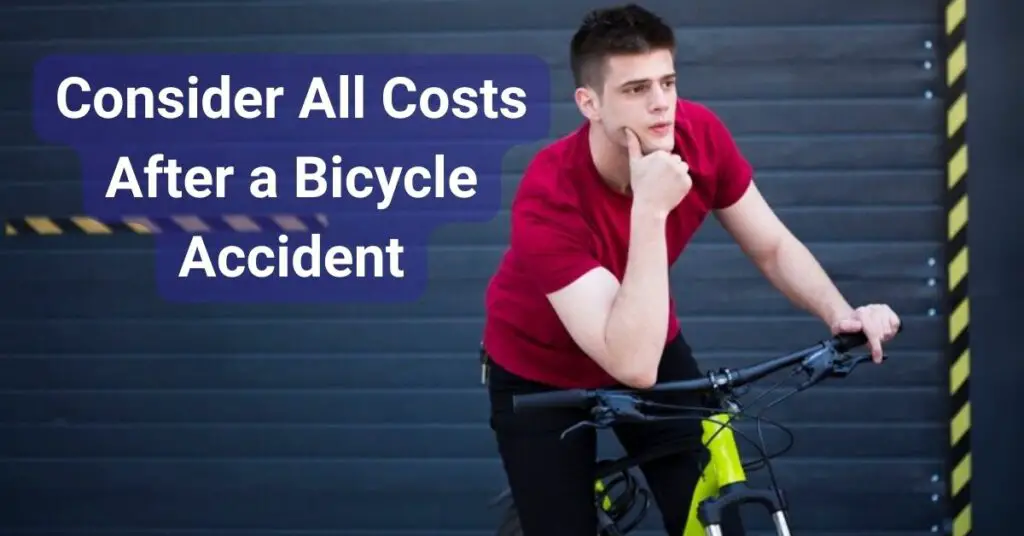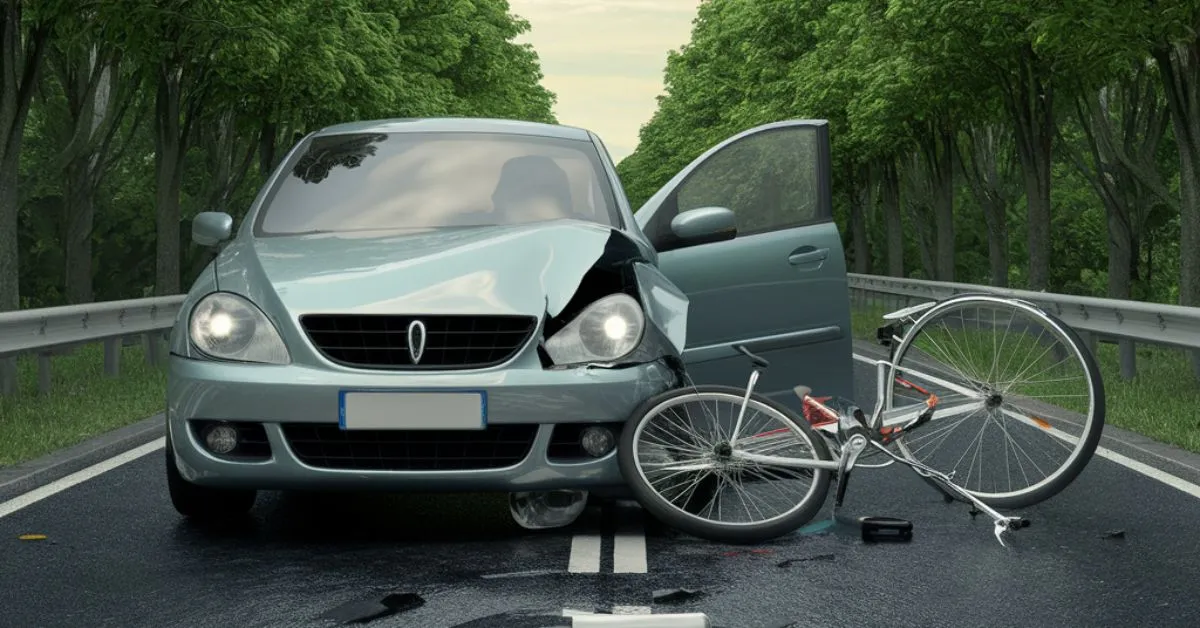Car insurance typically does not cover bicycle accidents. This is because bicycles are not considered motor vehicles under most standard auto insurance policies. However, there may be exceptions if the bicycle accident involves a motor vehicle.
If you are cycling and get hit by a car, the driver’s liability car insurance could help pay for your injuries and damages. This falls under the bodily injury and property damage portions of the policy.
If you hit another vehicle or pedestrian while riding your bicycle, the liability coverage on your own car insurance policy may provide protection. But bicycle accidents without a motor vehicle involved are usually not covered.
Insurance Policy Coverage for Bicycle Accidents

Insurance policy coverage for bicycle accidents can be confusing. Knowing which policies cover what is essential. Different insurance types can offer protection.
Car Insurance: If a cyclist is struck by a car, the driver’s liability insurance can pay for injuries and damages. Bodily injury may cover medical bills, while property damage covers bike repairs – but policy limits apply.
Uninsured Motorist Coverage: If a hit-and-run driver hits a cyclist with no insurance, uninsured motorist coverage on the cyclist’s own auto policy could cover injuries and lost wages – typical limits are $25,000 to $100,000.
Homeowner’s or Renter’s Insurance: The medical payments or personal liability portions of home/renter’s insurance may cover bicycle accidents happening away from the insured premises.
Health Insurance: Health insurance is the primary coverage for a cyclist’s medical bills from injuries sustained in an accident – whether hit by a car or in a solo incident.
Bicycle accidents can result in expensive damages. Having adequate insurance coverage through auto, home, health and potentially umbrella policies is crucial for all cyclists.
Factors affecting auto insurance coverage for bicycle crash
Factors affecting auto insurance coverage for a bicycle crash include several key elements. Understanding these can help you navigate your policy better. Let’s break down the main factors.
1. Injury severity: More severe injuries resulting in higher medical bills and longer recovery times increase the potential insurance payout.
2. Lost income: If bicycle accident injuries cause missed work, insurers may cover lost wages.
3. Pain and suffering: Severe injuries can qualify cyclists for compensation for physical and emotional trauma.
4, Insurance limits: Policy maximums cap how much can be paid out, so higher liability limits provide better protection.
5. Shared fault: If the cyclist shares partial blame, insurance payouts may be reduced proportionately under comparative negligence rules.
Determining liability and compensation
In bicycle accidents, fault and insurance payouts depend on who caused the crash.

Liability is usually assigned based on traffic laws and which party was negligent. Cyclists can be held liable if they broke rules like:
- Ignoring traffic signals
- Riding under the influence
- Not using bike lanes
- Passing improperly
- Not signaling when turning
If a motorist breaks laws and hits a cyclist lawfully riding, their insurance often pays damages. Evidence like photos, witness testimonies, and police reports help determine fault.
Related Article: Does Your Car Insurance Cover Restitution Costs? Find Out Now!
How does an insurance company cover bicycle accidents?
Insurance companies have specific procedures for handling bicycle accident claims. The process typically involves gathering evidence, reviewing policies, and determining fault.
If the cyclist was not at fault, the liable party’s insurance will cover damages. This may include medical bills, bike repairs, and other costs.
If the cyclist was at fault, their own insurance policies like auto or homeowners may still provide some coverage. Understanding your policies is crucial.
Who pays for the injury and losses?
Who pays for the injury and losses in a bicycle accident depends on who is at fault. The responsible party’s insurance usually covers the costs. Different scenarios affect how payments are made.
At-fault driver: If a negligent driver hits a cyclist following traffic laws, the driver’s auto insurance liability coverage pays. This handles medical bills, lost wages, bike repairs, and pain/suffering claims.
At-fault cyclist: When cyclists are at fault, their auto or homeowner’s insurance may still help cover some costs. But options are limited compared to when a motorist is liable.
Uninsured motorist or med pay coverage: If an uninsured driver hits a cyclist, these coverages on the cyclist’s policies pay expenses. Med pay covers initial medical costs regardless of fault.
Different types of claims regarding damages
Different types of claims regarding damages can arise after a bicycle accident. These claims help cover various costs and losses. They are generally categorized into economic and non-economic damages.
Economic Damages: These are the calculable monetary costs from the accident. Medical bills, lost wages, property damage repair costs, and other out-of-pocket expenses fall under this.
Non-economic Damages: More subjective damages are included here, such as pain and suffering, emotional distress, loss of enjoyment of life, and loss of consortium for family members.
Consider All Costs After a Bicycle Accident
After a bicycle accident, the costs can quickly add up. Medical bills pile up from the initial emergency care. Follow-up treatments and rehabilitation are often required too. Prescription medications, medical equipment like crutches, and ambulance fees add even more expenses.

Severe injuries may cause time off work, leading to lost income. If the accident results in a permanent disability, there could be a loss of future earning potential as well. Calculating all these costs is crucial for insurance claims.
Beyond just medical bills, accident victims may qualify for compensation for pain and suffering, emotional distress, and loss of enjoyment of life. These non-economic damages are also factored in.
Bicycle accidents have many hidden costs that aren’t always obvious upfront. Consulting a personal injury lawyer experienced in bike crashes can ensure all damages are accounted for when seeking a fair settlement.
Related Article: Does Car Insurance Cover Hail Damage? Find Out Now!
Frequently Asked Questions
If a cyclist gets hit by a car, whose insurance is responsible for paying the cyclist’s medical bills?
The driver’s bodily injury liability coverage should cover the cyclist’s medical expenses, as long as the driver was at-fault. The cyclist may need to file a third-party claim against the driver’s auto insurance policy.
What if the cyclist was riding against traffic laws when they were struck by a car?
If the cyclist was violating traffic laws and contributed to causing the accident, their compensation may be reduced based on their percentage of fault. However, the driver’s insurance would likely still provide some coverage.
Can a cyclist make a claim on their own auto insurance policy after a bicycle accident?
Yes, certain coverages like personal injury protection (PIP) or medical payments may help cover the cyclist’s own injuries, regardless of fault. Uninsured/underinsured motorist coverage can also apply if the other driver lacks insurance.
Will homeowners or renters insurance provide any coverage for bicycle accidents?
The liability portion of a homeowners or renters policy could potentially provide some coverage if the cyclist is found legally liable for injuring others or damaging property while riding their bicycle.
What economic damages are typically recoverable after a bicycle crash?
Economic damages include medical expenses, lost wages, property damage costs to repair or replace the bicycle, and any other out-of-pocket costs related to the accident injuries.
Are there any time limits for filing an insurance claim after a bicycle accident?
Yes, most insurance policies have strict notification deadlines, usually within 30 days of the incident, to report a claim. There are also statute of limitation laws that set time limits for filing injury lawsuits.
Final Thoughts
Bicycle accidents can result in serious injuries and costly damages. Determining what insurance will cover these expenses depends on specifics of the incident. If a negligent driver hits a cyclist, their auto liability policy should pay out.
If the cyclist broke traffic laws contributing to the crash, they may be held liable. In these cases, coverages like med pay, uninsured motorist, or even homeowners insurance could provide protection.
Ultimately, having adequate insurance is crucial for all cyclists. Health plans for injuries, and auto/home policies to cover liability and damages. Consulting legal experts ensures a full understanding of your rights and options after a bicycle accident.

I write professional blogs specializing in car insurance. My content delves into various aspects of insurance policies, providing valuable insights and tips for choosing the best coverage. My goal is to make complex insurance topics accessible and engaging for all readers.











